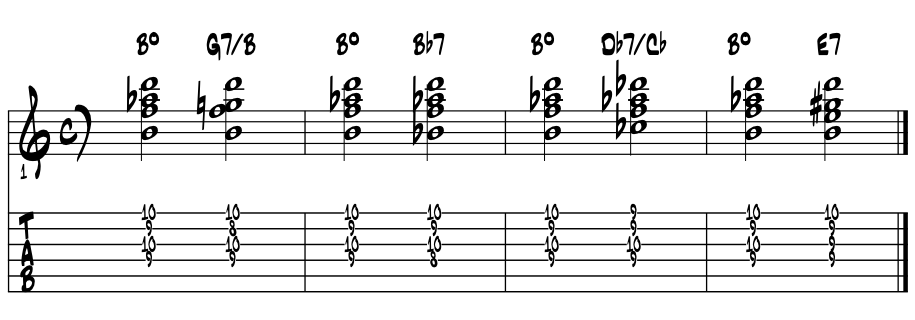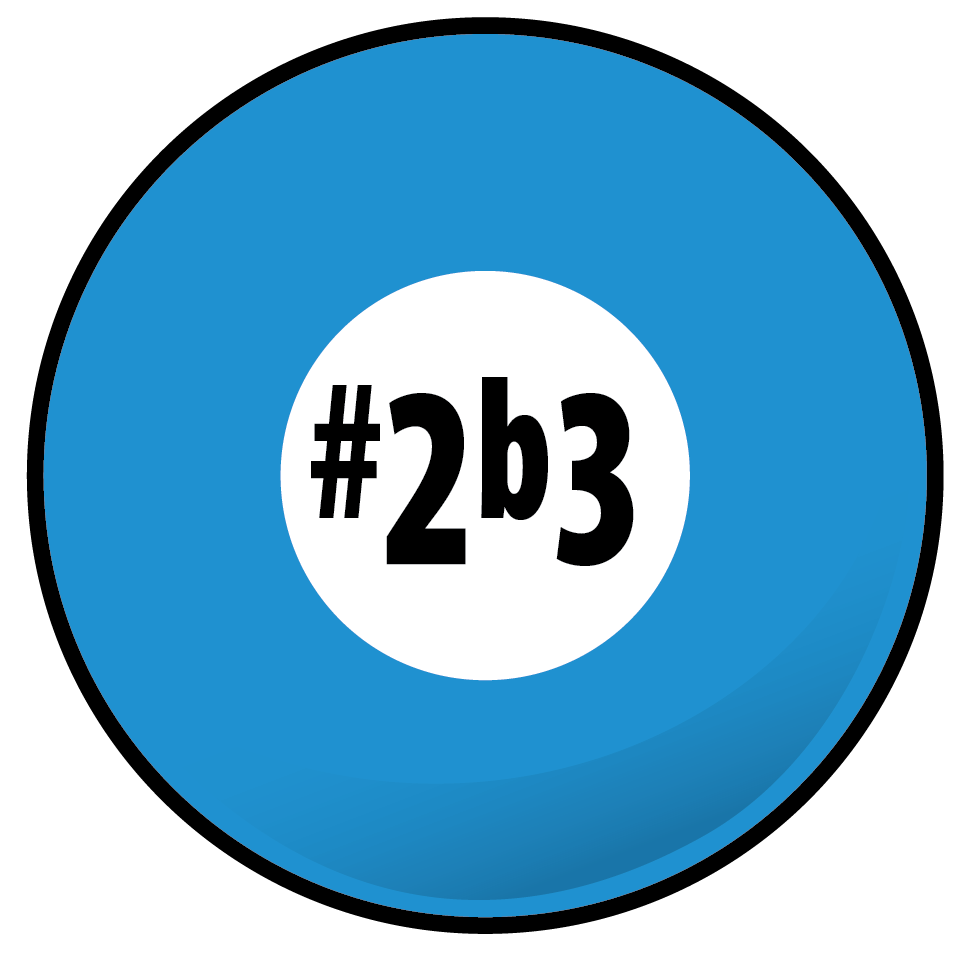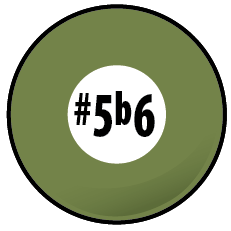~ Seven ~ leading tone ~ vii ~ ~ Locrian mode ~ half diminished chord ~ ~ major 7th interval ~ a penultimate ~
~ the diminished triad ~ ~ vii-7b5 ~ half diminished 7th ~ 'a pointing star within Americana musics ...'
|
In a nutshell. The leading tone / major Seven is the natural and diatonic leading tone in all things major; songs and melodies, arpeggios and chords and key centers, located a half step below the tonic note Eight. It is one half of the two pitch tritone energizer within V7. And the leading tone is the 'official' penultimate pitch, written into the theory as '7 up by half step to 8.' |
So why Seven? Explore the numbers. Example 1. |
|
|||||||||||||||||||||||||||
Measured from the root pitch One, we count up to Seven. Fingers work great for counting these numbers and pitches. The interval between them is a major 7th |
Theory names. For Seven, there's quite a few really, as some are for the triads and chords we diatonically build on Seven. We know Seven as the leading tone, home of the Locrian mode, as a major 7th, and of course, Seven. There's a diminished triad, and a half diminished 7th chord diatonically built on the seventh scale degree. |
Locrian mode. We have a diatonic mode on Seven. Termed 'Locrian', it's a deep shade of minor, creating a sense of wanting that has been long denied. Tricky at first cause it bristles a bit, it can float for a long time, not ever giving up. Please examine the major 7th interval, the diatonic diminished triad and the Locrian mode. Example 1a. |
 |
Are you catching the sense of unresolved melodic line? That there is a sense of forward motion to the direction of the line / triad that might be seeking a resolution? A half step to a new location of potential resolution ? |
Locrian mode. Songs written in Locrian mode are hen's teeth rare. As its intervals buck 5000 years of composing lore. The double minor 3rd of the diminished triad built on its tonic creates a challenge when compared to the more traditional composing tonalities. Not to say Seven doesn't stay busy, for surely it is one of our longstanding traffic cop partners keeping all things cookin' and grooving along on Melody Lane. |
Interval of a major 7th. In finding the interval of the major 7th above a root pitch we can simply count our pitches diatonically to Seven. Please examine the pitches in C major. Example 2. |
|
|||||||||||||||||||||||||||
So why so important? Well as its name implies, the leading tone directs our melodies towards a definite resolution found on One. And with resolution, our stories have a way to convincingly end. the tale |
In the following idea, we've a clear and an undisguised destination of our melodic line, all heading to the tonic pitch 'C.' Example 2a. |
Master of the obvious? :) Pretty clear that our melody is heading to our tonic pitch 'C' yes? Well crafted tunes will do this; tell a good story, often have a catchy hook, gets our toes tapping and everyone who listens can easy follow along, knowing exactly where the music is going to go. The 'aural predictability' of it all. |
An American classic. People love to sing. There's just something in it that lights us folks up. The tail end of the following melody gives us a clear example of the leading tone resolving to its tonic pitch. Everyone probably knows this song from way back, we usually learned it as kids. Learn it here if needed, ...'cause it's one ... two ... three strikes your out at the ... Example 3. |
 |
Cool ? Pretty popular all Americana song. And like the national anthem itself, slips in a sharp Four magic. |
Americana melodies. In the pentatonic and blues flavored melodies of many folk, bluegrass, country, blues and rock tunes, we don't really hear this leading tone pitch stand out as in the last melody. And of the 30 melodies included in this work, only 11 feature the leading tone as the penultimate pitch, ( still batting 330 or so :) And if neither the pentatonic or blues scale groups contains a leading tone, the where is its 'leading' role in these styles? |
In the chords, the harmony? Exactly. You probably could hear in the first example above how close the diminished triad built on Seven sounds to our V7 chord. Building chords with the pitches of 'C' major, compare the vii diminished triad with 'G7' (V7) voicings. Ex. 4. |
 |
Fairly close yes? And why diminished? In this minor triad on Seven, its perfect 5th is lowered by half step, thus to a diminished 5th. |
Simply a different root pitch? Pretty much, but it is the dominant root pitch of a key center. Sense how the 'B' diminished color 'stabilizes' with the addition of the 'G' root note? In each of the four measures above, the pitches of the 'B' diminished triad become the 3rd, 5th and b7 pitches of the 'G7' chord. Please examine the pitches by letter name in a table format. Example 4a. |
|
Locate the pitches of the 'B' diminished in the 'G7' chord in the above table? So while in any of our blues' hues influenced styles, the leading tone is often very absent in the melody, it's almost always somewhere in the harmony that supports these melodies. As we can hear in the last musical example, the 'B' natural is readily absorbed in the 'G7', as it is the 3rd of the 'G' major triad. |
Are there any problems with slight disparities between our melody notes and chord notes? Nope. For the bass line story help to keep it all on the up and up. That's just part of our beloved Americana blues rub, a sound that has changed the world's musics at least a couple of times over the last century or so. |
Common resolutions. These next few ideas find ways to resolve the leading tone pitch as we find it within common guitar chord shapes. Thinking 'C' major, our leading tone is 'B', the following possibilities emerge. Example 4b. |
All of 'G' chords in the last example have a 'B' natural leading tone pitch. The first two bars are triads with doubled pitches. The third adds in the blue hue and with the last we add some colortones to our Five to One cadential motion. |
Seven ~ vii7b5 ~ adding the 7th. Anytime we start to think of evolving the triads by adding in a 7th, it can be a game changer in the theory / styles whole tamale dynamic. For in doing so we nudge up against our core philosophy of this work, the correlation between number of pitches in a song's melody and its musical style. Adding a seventh also brings the theory of chord type into our discussions. For chords, it's often simply about extending the arpeggios; 7, 9. 11, 13. For our rhythms, the subdivision of the beat. And for melodies; the number of different pitches in the line. |
That we evolve our music theory simply by adding in new pitches to our vocabularies, right up to the 12 of the chromatic scale, tracking how each new additional pitch brings new stylistic possibilities. We also further our potentials beyond these 12 through the blues and its various pitch rubs and bends, as well as by building bigger arpeggios, which historically have been the the basis of new jazz directions. |
Seven / diatonic seventh chord / vii -7 b5. Thinking diatonically, to the diminished triad built on Seven we add a blue 7th, and in doing so we create the minor 7th b5 / or half diminished 7th chord. Quick review. The half diminished 7th chord is diatonic to the relative major / minor group. The minor 3rd symmetrical fully diminished 7th chord is not. Compare their letter names from the root pitch 'B.' half / B D F A full / B D F Ab Cool ? Knowing diatonic, 'through the tones' is the key here. Next, examine the pitches in 'C' major. Common chord symbols include the 'circle / line thru 7' for jazz and the more common spelling out of the '-7b5' usually everywhere else. And with minor 7, we can think Two chord type, the b5 note is pure diatonic. Thinking here in 'C' major and finding the pitches diatonic Seven 7 in letters then pitches. Dig the opening reverse arpeggio, getting us to the leading tone resolution on the lower pitches, the with chords resolving to One. Example 5. |
|
 |
Cool ? That's the basics of the 'Seven seven' chord and welcome into the world of the diminished 7th colors. |
Seven is Two in the relative minor / ii -7 b5. Songs written in a minor key diatonically include the half diminished color as its diatonic Two chord, when created from our natural minor group of pitches. Thinking now in 'A' minor, relative minor to 'C' major. Example 5a. |
|
 |
Gets rather somber towards the close of the last idea yes? Well, that's where the half diminished lives on our palettes of aural musical color. The blue to trending to rich purple of indigo, the longing, passionate endlessly sustaining point on the spectrum of our aural colors. |
Where in the spectrum of styles. Diatonic half diminished 7th can always bring the blues. A deepening of the minor colors and a half step away from a theory kaboom. While hen's teeth rare in children's songs, even in minor keys too, same for near all folk music and its brethren of bluegrass, newgrass, jamband, country and on into rock and beyond, while the half diminished 7th color is there and available, rare is it clearly struck as such. That is, until some blue arrives. That blues begets jazz and then all is available, for in both blues and jazz, Seven 7 plays a solid role all through the literature, doubled up in minor keys. In this next idea, examine the different voicings for basic style approaches with motion between One and Six, with 'Seven 7' in between. Example 5b. |
 |
Cool ? Recognize the sounds ? Try again. In the blues, while the root motion to the leading tone Seven is not all that common, its diatonic half diminished 7th chord color is quite common, but its place in the theory is a wee bit different. Turns out that in the upper part of our V9 chord, the super common blues / funk color that walks wide through R and B / jazz Americana, resides the four pitches of the diatonic half diminished 7th chord. So we can easily substitute one chord for another, it's diatonic so it is built right in. Nothing fancy here, just different segments of the same arpeggio pitches. Please examine the letter name pitches and then some common chord voicings of this theory. Example 5c. |
|
 |
Cool? A slippery way to get to Four huh ? And always good for chord voicings to give the bass its space :) These last ideas use inversions to get us off the root pitch of the chords, to lighten the texture a bit and add some new colors to the harmony, all diatonic. |
Half diminished setting up the final hold. A rather fun and quite common ending in a jazzy tradition is to use the tonic pitch of a song 'in the lead', and voice various chords underneath it, as we descend by half step to the final hold. In G' major. Example 5d. |
 |
Know this lick ? If necessary, learn it here and share it with your mates. This kind of idea creates a cool spot for featuring the drummer. Take any quartet that swings, add this coda onto the arrangement and viola ... instant bigger band. For a few bars anyway :) Another nice thing about big band swing is their rhythms actually swing. So super easy to find a few arrangements you dig and sing along with the recording. In doing so, internalize the time and magic of swing with your voice as your instrument. Use these rhythms to make your own single note lines swing. Sing to swing. For once we swing when we sing, we got it forever. And internalized and 'roted in', we have a better chance to apply it in any music where a bit of swing is appropriate. The stack of big band vinyl records has gotta be 100 feet tall these days. Highlight and click each of the stars named, a bio for all of these big band drummers lives on Wiki, for a quick start to further explorations of your choosing big band music to enjoy. |
|
Paired with b9 ~ backpedaling with half diminished. In this next idea we use what becomes a common enough feature in jazz standards that pairs up the half diminished color with non-diatonic pitches to cycle some dominant chords as V7b9. This makes the 'b5' and the 'b9' color tone a 'common tone' between these chords. In theory, these become 'Two / Five' cells which very often gets backed towards our tonic pitch. In this next idea, we start on Four and cycle our way to One in 'C' major. Example 5e. |
 |
Charlie Parker's "Confirmation", thought by legit history to be the granddaddy of em' all, rolls along the lines of these backpedaling, organized cycle of chord changes. Why do we do this? More chords, more melodic options, twists and turns, borrow pitches, non diatonic sequences, any and all really playing 'through' the changes. |
|
~ yet another super theory game changer ~ |
Seven ~ fully diminished 7th relative. We in theory have three different 7ths to explore. Each of these can extend any triads pitches. Leading tone for major, minor 7th for minor, and this minor 7th interval further reduced by half step to become diminished. Please examine the pitches. Example 6. |
|
||||||||||||||||||||||||||||||||||||
Thus there are three types of seventh as measured from their root pitches and placed atop a major, then diminished triad; leading tone, minor and diminished. |
So two options for now, half or fully diminished. As their sound is nearly identical, no wonder they oftentimes create a bit of theory confusion. And while the difference is slight, the theoretical ramifications of their individual uniqueness can be giant. Sound out these additional, closely related, voicings of the half and fully diminished colors. Example 6b. |
 |
Compare the juice. Tough to hear the slight shift as the pitches go up yes? Click it again please. So as Seven is the diatonic leading tone chord resolving to One, we can hot rod the thing and get a bit more wallop by changing one pitch, making half into full diminished 7th chord. Compare the following resolutions. Example 6c. |
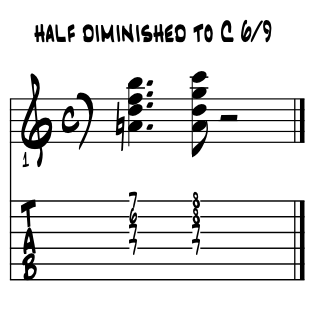 |
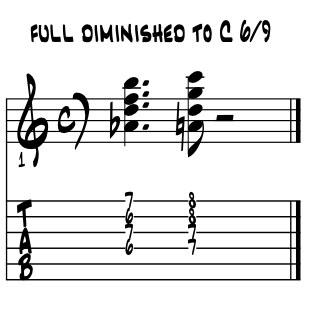 |
Well ... ? Too close to call? That happens sometimes with digital mp3's and such. Which one sounds better for ya? Remember too, the fully diminished resolution here is a jazz style motion. So initially, it just might be a wee bit on the cooler side, as a symmetrical chord shape with its extra bit of pop, the full diminished adds some bristly 'oomph.' And these are the pitches and chord shape that is the upper part of the V7b9? Yes indeed. Thinking of G7b9; 'G'7b9 / G B D F Ab ~ B D F Ab / 'B 'full dim 7th |
Full diminished ~ a perfect symmetry. As the fully diminished color is created exclusively with the interval of a minor third, its perfect symmetry opens up doors not fully quite available to its diatonic half diminished cousin. Advancing modernes, moving in an improv and jazz direction, can use this bold color today just as so many have in the past; as a catalyst to create new pathways for traditional cadential motions, thus new challenges and explorations for their musics. New harmonies bring new improvisational possibilities. |
A one pitch change and voila. This next idea baselines a lot of the fully diminished 7th chords theory. Dig its evolutions as we alter it 7th by half step. Example 6d. |
arpeggio degrees |
root / 1 |
3 |
5 |
7 |
|
B -7b5 |
B |
D |
F |
A |
7th raised by 1/2 step |
B diminished 7th |
B |
D |
F |
Ab |
|
G 7 |
B |
D |
F |
G |
7th lowered by 1/2 step |
 |
Even inverted, a pretty clear sounding G7 chord completes the transformation of the pitches into sound. Here's a fuller version of the above theory idea. |
Diminished evolutions. Thanks to the closeness of these two diminished colors, we can evolve any of our fully diminished chord's four pitches into four half diminished chords simply by raising any one pitch of the arpeggio by half step. Note enharmonic spellings. Example 6e. |
diminished 7th arpeggio |
B |
D |
F |
Ab |
D -7b5 |
C |
D |
F |
Ab |
F -7b5 |
B (Cb) |
Eb |
F |
Ab |
Ab / G# -7b5 |
B (Cb) |
D (Ebb) |
F# (Gb) |
Ab |
B -7b5 |
B |
D |
F |
A |
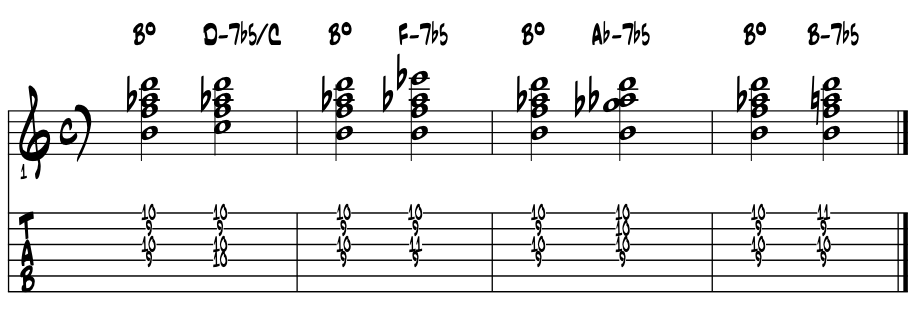 |
Rule of thumb. Cool ? Such close colors crazy ! Raising one pitch of the diminished 7th chord, it becomes the b7 of the half diminished chord. There are four pitches, so four chords, which are all related together by the consistent minor 3rd construction interval. |
|
~ chord substitution / super theory game changer for jazz ~ |
Kaboom. Another evolution from the fully diminished 7th is by lowering any one of its pitches by half step to create a vanilla V7 chord. Please examine these evolutions with letter name pitches. Example 6f. |
|
Rule of thumb. Cool ? Lowering one pitch of the four, it becomes the root note for a V7 chord. So with four notes in our fully diminished 7th chord, we get four V7 chords? Yep. B dim 7 = G7, Bb7, Db7, E7. And can we pair this with their diatonic Two chords and expand each cell? Sure, why not :) |
Review / just more theory magic. From the above charts we learn that each of the four half diminished chords neatly pair up with one of the four V7 chords. And that the tritone sub / V7 chord for each -7b5 is available also? Here are the pairings. Example 6g. |
major |
tritone sub |
resolution |
ii-7b5 |
. |
. |
D -7b5 |
Ab- Db7 |
C / A- |
F -7b5 |
B- E7 |
Eb / C- |
Ab / G# -7b5 |
D- G7 |
Gb / Eb- |
B -7b5 |
F- Bb 7 |
A / F#- (Gb) |
The diminished catalyst. Surely and needless to say, that the diminished colors end up having multiple resolving properties thanks to their leading tone potentials. Found in our fully diminished seventh chords and related diminished scales, we use the theory to generate new ideas for chord progressions that in turn offer nuanced and even new melodic support. |
In energizing this process, we examine what the diminished color is capable of doing and find new pathways to follow, then disguise its distinctive color by filtering it back through various filters, more diatonic sounding softening techniques, and yet still follow the pathways its theories has shown us. 'Sheets of sound ?' Maybe. |
"Learn the rules like a pro so you can break them like an artist." |
wiki ~ Pablo Picasso |
~ super theory game changer ~ |
Seven ~ minor keys. Just about any song written in a major key with major chords will probably have this leading tone, 7th scale degree pitch. But what about the minor tonality? Diatonically, the 7th degree is a minor 7th, so not a leading tone / half step from the tonic 7th. Are there other options to the 7th in minor ? U bet :) Please examine the pitches and possible 7th's in 'A' minor. Example 7. |
|
Natural minor. This group of pitches is of course also our relative minor scale to our diatonic major. We can see the flat Seven as a whole step below our tonic pitch. |
Harmonic minor. In creating the harmonic minor grouping, we evolve our group by essentially picking up the leading tone 7th, a half step below our tonic pitch. Is this the same leading tone as with the major scale? Yep sure is. Exactly the same. So we gain this strength of melodic motion which morphs our diatonic Five chord from a minor triad to major. By ear, compare the pitches. Example 7a. |
Cool ? Yea, with the new leading tone, our Five becomes a bit more dominant. Do read on ... |
Theory / practice. In theory of course we gain the leading tone and again the idea that in most of the Americana music in the minor keys, we do not hear the leading tone in the melody, but super deep love the pitch in our chords. Especially in the blues stylings. A common example of this is the V7#9 chord. This chord is often called the "Jimi" chord, and from the tonic contains both the diatonic flat seven and the leading tone 7th in one potent chord. Examine the pitches and sound of this essential blues / rock / jazz chord. Example 7b. |
|
|
 |
Where in the music? This #9 chord is a key player in lots of blues and rock tunes over the decades. Innovative blues guitarist Jimi Hendrix has it right out front in a couple of his big hits. As we can hear in this last example, the V7#9 color strongly sets up, and firmly directs, the resolution to the tonic minor. |
This V7#9 chord contains essential pitches we can use to create a blues rub. Where melody pitches and its supporting harmony feature pitches a half step apart from one another, to create the true blue dissonance. Let's extract the 'rub' pitches from 'E7#9' to hear it all more clearly. Example 7c. |
 |
Neat huh? This simple clash of the pitches is a big part of what makes Americana music Americana music. This pairing of dissonant pitches we simply call the blues, and along with the core 2 and 4 pocket / backbeat of the Americana groove, combine to create the overall magic found in no other indigenous musical styles globally. Uniquely Americana? In its origins? Absolutely. Other blues 'rubs ?' Yep, there's a few. |
~ super theory game changer ~ |
Anything else? Indeed as the harmonic minor group is our diatonic source for the fully diminished 7th arpeggio and its chord. Really? Yep. Any other sources for this symmetrical minor third interval build? No, for there's nothing really strong enough, as a loop of pitches, to create a sense of functioning key center. |
Yes, we can find our diminished arpeggio diatonically from the pitches of the symmetrical diminished scale too. But this source runs into concerns over its admin abilities to function as a key center. Are there any Americana songs in the key of 'G#' diminished ? Maybe google it :) Regardless, please examine the pitches as we locate the fully diminished 7th arpeggio from the harmonic minor group of pitches. Any guesses as to which scale degree we'll find it on? Examine the pitches. Example 7d. |
|
Surprise surprise surprise, Seven ! And as the harmonic minor group has a perfect 5th above the root, thus a dominant pitch, we get a solid diatonic core of a root to perfect fifth interval, a true dominant pitch and super solid V7 b9 chord, plus a solid One / Four and Five in triads, all combined stands up rather nicely as a key center on its own merits. |
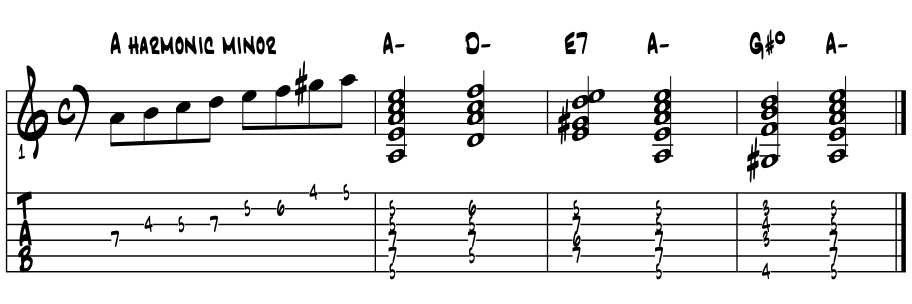 |
Melodic minor. This next evolution grouping of the minor pitches we call the melodic minor group, it simply raises the 6th scale degree while keeping the leading tone 7th. Like the major 6th and 7th in a major scale? Yep. Compare their pitches and sounds. Example 7e. |
|
 |
Hear the evolution as the pitches morph our minor colors back towards major? Melodic minor can be just that, consonantly more melodic in its approach to the tonic pitch as the wider, minor 3rd gap of Six to Seven of the harmonic minor is reduced to a whole step, so just less minor, there are degrees of just how minor we go yes ? |
While there is a case for using an ascending melodic minor and descending natural minor pairing in legit theory, and this we draw from European music theory, we Americana composers can choose to concern ourselves or not, with this possibility, all depending on what we hear and the pitches we need. |
Improvisation. For the evolving jazz improvising artist, the melodic minor grouping creates some fascinating possibilities in regards to scale / chord substitution possibilities. Within Essentials, these opportunities are organically theorized two ways. |
One perspective is a softening of the diminished color and its multiple leading tone resolving properties. We'll simply soften the diminished sounds to melodic minor and filter things much the same way. |
A second way is to view the melodic minor grouping as a mode of the popular Lydian flat Seven or vice versa. Explore the improv links if curious to these possibilities. Please examine and compare the pitches of melodic minor group and Lydian flat 7. Example 7f. |
|
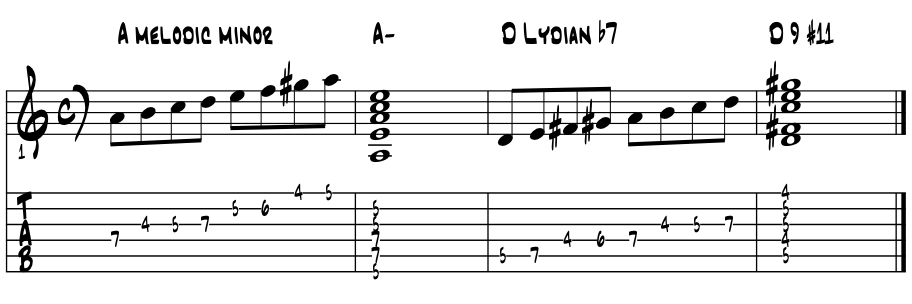 |
Cool huh? The last voicing is a tricky fingering shape for sure. So depending, maybe consider leaving off the root as the upper four pitches are a fairly common augmented chord shape. |
Review and forward. As its theory name implies, the leading tone Seven is our directional pitch. With the numerical majority of our songs written in the major key, the diatonic leading tone of Seven becomes an essential arbiter of the tension / release dynamic within the music. And while our Americana melodies are so often blues influenced, and thus shy away from the leading tone in the melody line, in all things major key we can be sure to find the leading tone pitch in the harmony. Most often directing things from within the dominant chord, the V7 'traffic cop' of American music. The one Frosty The Snowman ran into ? ... could very well be :) |
|
"That's one of the wonderful things about science; not a one of us has to believe it and yet ... it can still be 100% correct." |
'paraphrased from a local Alaskan bumper sticker about the power of faith' |
 |
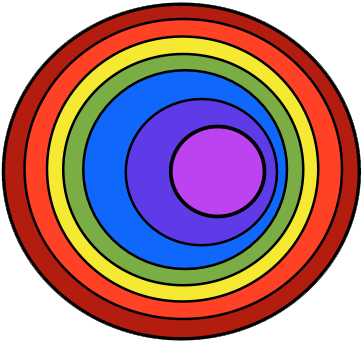 |
|||||||||||
 |
 |
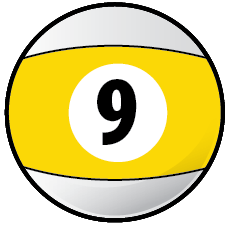 |
 |
 |
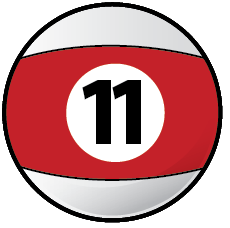 |
 |
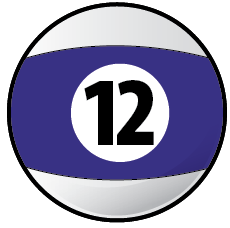 |
 |
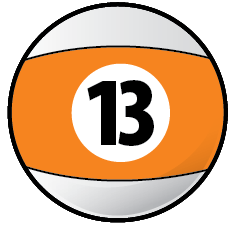 |
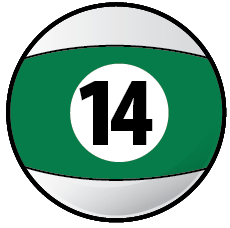 |
 |
 |
References. References for this page's information comes from school, books and the bandstand and made way easier by the folks along the way. |
Find a mentor / e-book / academia Alaska. Always good to have a mentor when learning about things new to us. And with music and its magics, nice to have a friend or two ask questions and collaborate with. Seek and ye shall find. Local high schools, libraries, friends and family, musicians in your home town ... just ask around, someone will know someone who knows someone about music and can help you with your studies in the musical arts. |
|
Always keep in mind that all along life's journey there will be folks to help us and also folks we can help ... for we are not in this endeavor alone :) The now ancient natural truth is that we each are responsible for our own education. Positive answer this always 'to live by' question; 'who is responsible for your education ... ? |
Intensive tutoring. Luckily for musical artists like us, the learning dip of the 'covid years' can vanish quickly with intensive tutoring. For all disciplines; including all the sciences and the 'hands on' trade schools, that with tutoring, learning blossoms to 'catch us up.' In music ? The 'theory' of making musical art is built with just the 12 unique pitches, so easy to master with mentorship. And in 'practice ?' Luckily old school, the foundation that 'all responsibility for self betterment is ours alone.' Which in music, and same for all the arts, means to do what we really love to do ... to make music :) |
 |
"These books, and your capacity to understand them, are just the same in all places. Always bear in mind that your own resolution to succeed, is more important than any other one thing." |
|
Academia references of Alaska. And when you need university level answers to your questions and musings, and especially if you are considering a career in music and looking to continue your formal studies, begin to e-reach out to the Alaska University Music Campus communities and begin a dialogue with some of Alaska's finest resident maestros ! |
|
~ |



